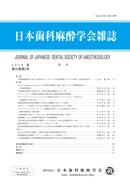Volume 46, Issue 2
Displaying 1-16 of 16 articles from this issue
- |<
- <
- 1
- >
- >|
Original Article
-
2018Volume 46Issue 2 Pages 57-61
Published: 2018
Released on J-STAGE: April 15, 2018
Download PDF (566K)
Short Communication
-
2018Volume 46Issue 2 Pages 62-64
Published: 2018
Released on J-STAGE: April 15, 2018
Download PDF (1452K) -
2018Volume 46Issue 2 Pages 65-67
Published: 2018
Released on J-STAGE: April 15, 2018
Download PDF (699K) -
2018Volume 46Issue 2 Pages 68-70
Published: 2018
Released on J-STAGE: April 15, 2018
Download PDF (247K) -
2018Volume 46Issue 2 Pages 71-73
Published: 2018
Released on J-STAGE: April 15, 2018
Download PDF (185K) -
2018Volume 46Issue 2 Pages 74-76
Published: 2018
Released on J-STAGE: April 15, 2018
Download PDF (288K) -
2018Volume 46Issue 2 Pages 77-79
Published: 2018
Released on J-STAGE: April 15, 2018
Download PDF (2100K) -
2018Volume 46Issue 2 Pages 80-82
Published: 2018
Released on J-STAGE: April 15, 2018
Download PDF (279K) -
2018Volume 46Issue 2 Pages 83-85
Published: 2018
Released on J-STAGE: April 15, 2018
Download PDF (5233K) -
2018Volume 46Issue 2 Pages 86-88
Published: 2018
Released on J-STAGE: April 15, 2018
Download PDF (2339K) -
2018Volume 46Issue 2 Pages 89-91
Published: 2018
Released on J-STAGE: April 15, 2018
Download PDF (11862K) -
2018Volume 46Issue 2 Pages 92-94
Published: 2018
Released on J-STAGE: April 15, 2018
Download PDF (270K) -
2018Volume 46Issue 2 Pages 95-97
Published: 2018
Released on J-STAGE: April 15, 2018
Download PDF (1501K)
Report
-
2018Volume 46Issue 2 Pages 98-101
Published: 2018
Released on J-STAGE: April 15, 2018
Download PDF (8803K) -
2018Volume 46Issue 2 Pages 102-104
Published: 2018
Released on J-STAGE: April 15, 2018
Download PDF (419K) -
2018Volume 46Issue 2 Pages 105-107
Published: 2018
Released on J-STAGE: April 15, 2018
Download PDF (376K)
- |<
- <
- 1
- >
- >|
